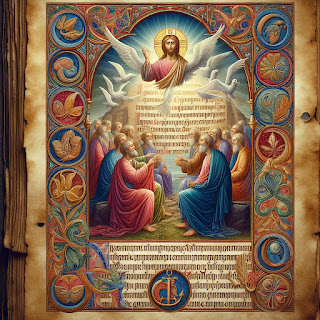Introduction:
The Gospel of Philip, one of the many texts discovered in the Nag Hammadi Library in Egypt in 1945, is a significant piece of early Christian literature that offers unique insights into the beliefs and practices of early Christian communities. This non-canonical gospel is attributed to Philip the Apostle, although its authorship remains uncertain. Written in Coptic, likely in the 3rd century AD, the Gospel of Philip is a treasure trove of esoteric teachings, mystical interpretations, and profound insights into the nature of spirituality and the divine.
Content:
1. Historical Background: The Gospel of Philip is part of a collection of Gnostic texts found in the Nag Hammadi Library, which includes other renowned works such as the Gospel of Thomas and the Gospel of Mary. Gnosticism was a diverse religious movement that emerged in the early centuries of Christianity, characterized by its emphasis on secret knowledge (gnosis) as the path to salvation and enlightenment.
2. Themes and Teachings: The Gospel of Philip explores various themes, including the nature of the divine, the relationship between the physical and spiritual realms, the role of ritual and sacraments, and the significance of gender symbolism. Unlike the canonical gospels, which focus primarily on the life and teachings of Jesus Christ, the Gospel of Philip delves into more abstract and metaphysical concepts.
3. Sacramental Theology: One of the central motifs in the Gospel of Philip is the concept of sacraments or mysteries (sacraments) as vehicles for spiritual transformation and union with the divine. It discusses baptism, the Eucharist, and the bridal chamber ritual as means of attaining spiritual rebirth and enlightenment.
4. Gender Symbolism: The Gospel of Philip employs rich symbolism, particularly regarding gender, often portraying the relationship between Jesus and his disciples, particularly Mary Magdalene, in symbolic and allegorical terms. It suggests a profound spiritual partnership between Jesus and Mary Magdalene, emphasizing the importance of feminine wisdom and spiritual insight.
5. Cosmology and Creation: This gospel presents a unique cosmology, describing the universe as emanating from the divine through a series of aeons or spiritual realms. It offers a symbolic interpretation of the creation narrative, emphasizing the divine spark within each individual and the potential for spiritual ascent.
6. Critique of Orthodox Christianity: Like other Gnostic texts, the Gospel of Philip critiques mainstream Christianity and its understanding of salvation, redemption, and the nature of God. It challenges conventional interpretations of scripture and offers alternative perspectives on Christian theology.
7. Legacy and Influence: Despite not being included in the New Testament canon, the Gospel of Philip has had a significant impact on Christian thought and spirituality. Its teachings have inspired countless individuals seeking a deeper understanding of the Christian faith and its mystical dimensions.
Overview and Themes
Sacraments and Rituals
The Gospel of Philip places a strong emphasis on the importance of sacraments, especially the sacraments of marriage and the bridal chamber. These sacraments are viewed as essential for spiritual progression and enlightenment. The text suggests that these rituals have the power to unite believers with the divine.
Knowledge (Gnosis) and Truth
Central to the Gospel of Philip is the concept of gnosis—secret knowledge that leads to salvation. The text emphasizes that true knowledge is a deeper, mystical understanding of divine realities, which contrasts with the superficial faith based on ignorance. This knowledge is presented as essential for overcoming the material world and attaining spiritual freedom.
The Role of Jesus
In the Gospel of Philip, Jesus is depicted not just as a savior but also as a teacher who imparts secret wisdom to his followers. His teachings focus on inner transformation and the realization of divine truths. Jesus is also portrayed as the spiritual bridegroom, and his relationship with Mary Magdalene is given particular significance, often interpreted symbolically.
Critique of the Material World
There is a strong dualistic theme throughout the text, contrasting the corrupt material world with the pure spiritual realm. The material world is seen as a realm of darkness and ignorance, from which the soul must escape. This dualism is a hallmark of Gnostic thought, which often sees the material world as created by a lesser deity, distinct from the true, benevolent God.
Key Passages and Concepts
The Bridal Chamber
The sacrament of the bridal chamber is one of the most enigmatic elements of the Gospel of Philip. It is described as a mystical union that transcends physical marriage, symbolizing the union of the soul with the divine. This union is seen as necessary for achieving spiritual rebirth and enlightenment.
The Pearl and the Treasure
These metaphors are used to illustrate the value of hidden spiritual knowledge. Just as a pearl or a treasure must be sought out and uncovered, so must the true knowledge of God be discovered through spiritual effort and insight.
Light and Darkness
The text frequently contrasts light and darkness, symbolizing knowledge and ignorance. Light represents the divine truth and the presence of God, while darkness represents the ignorance and falsehoods of the material world.
Interpretation and Influence
The Gospel of Philip is considered a key text in understanding early Gnostic beliefs and practices. Its emphasis on secret knowledge and mystical union provides insight into the spiritual practices and theological perspectives that diverged from orthodox Christianity. The text’s focus on the bridal chamber and the sacraments indicates a unique ritualistic aspect of Gnostic worship.
Scholars often debate the interpretations of various passages, especially the references to sacraments and the nature of Jesus’ relationship with Mary Magdalene. Some view these elements as purely symbolic, while others suggest they indicate historical practices or beliefs.
Conclusion
The Gospel of Philip is a complex and richly symbolic text that provides a window into the mystical and esoteric dimensions of early Christianity. Its themes of secret knowledge, the importance of sacraments, and the dualistic view of the world reflect key aspects of Gnostic thought. This gospel challenges traditional narratives and invites readers to consider the deeper, spiritual meanings behind religious practices and teachings.
